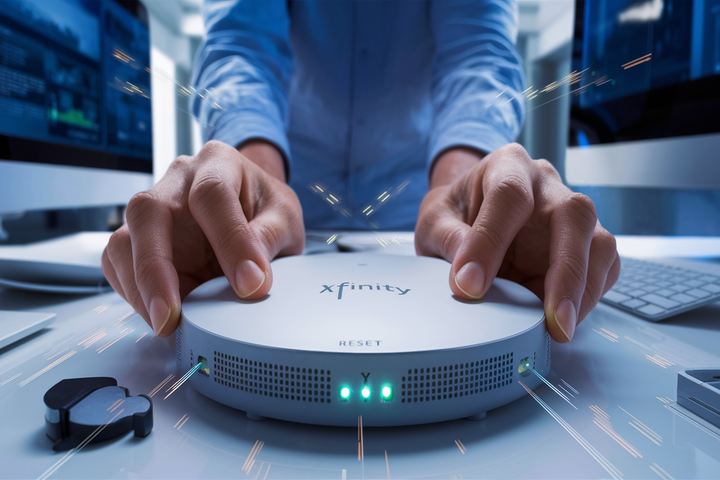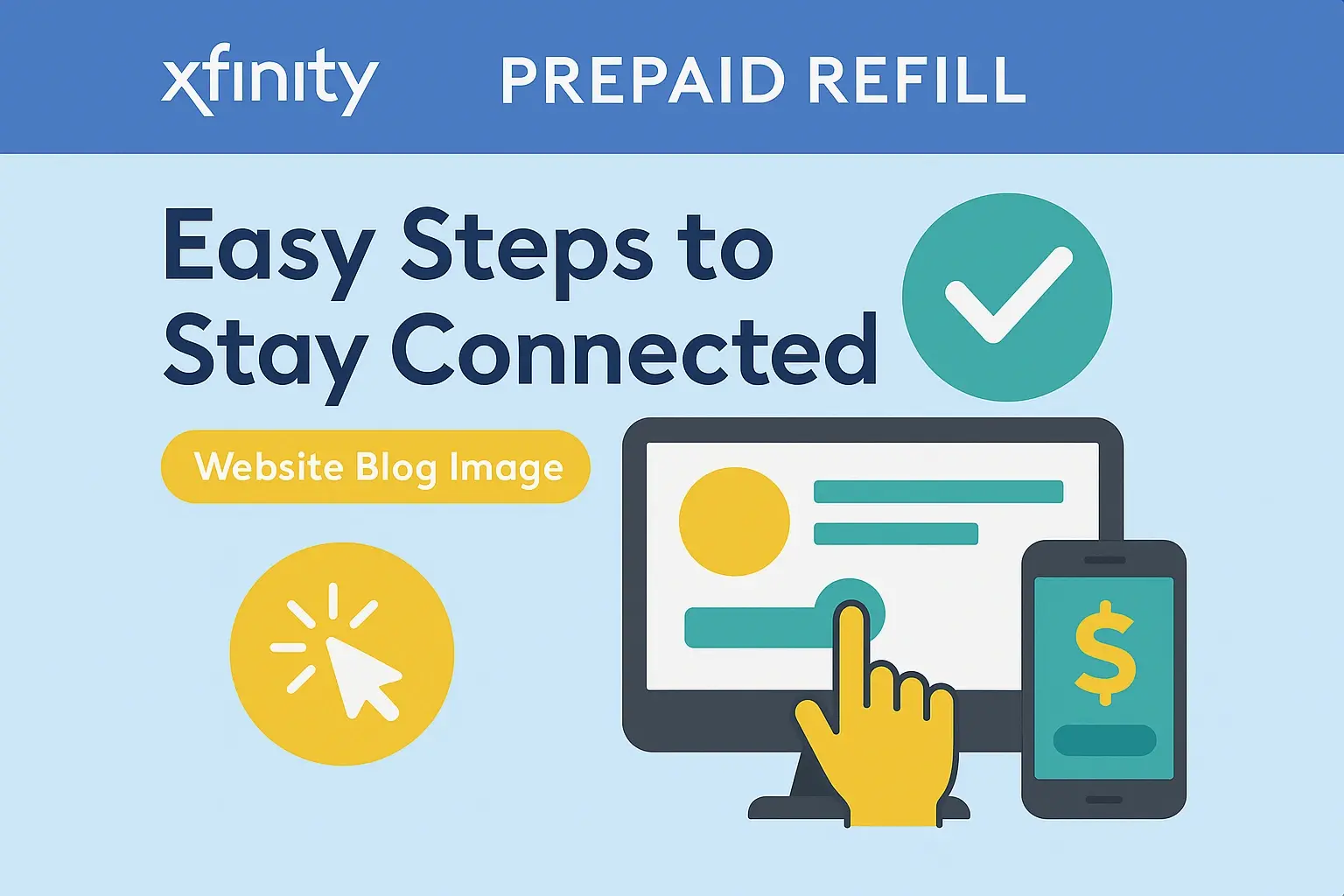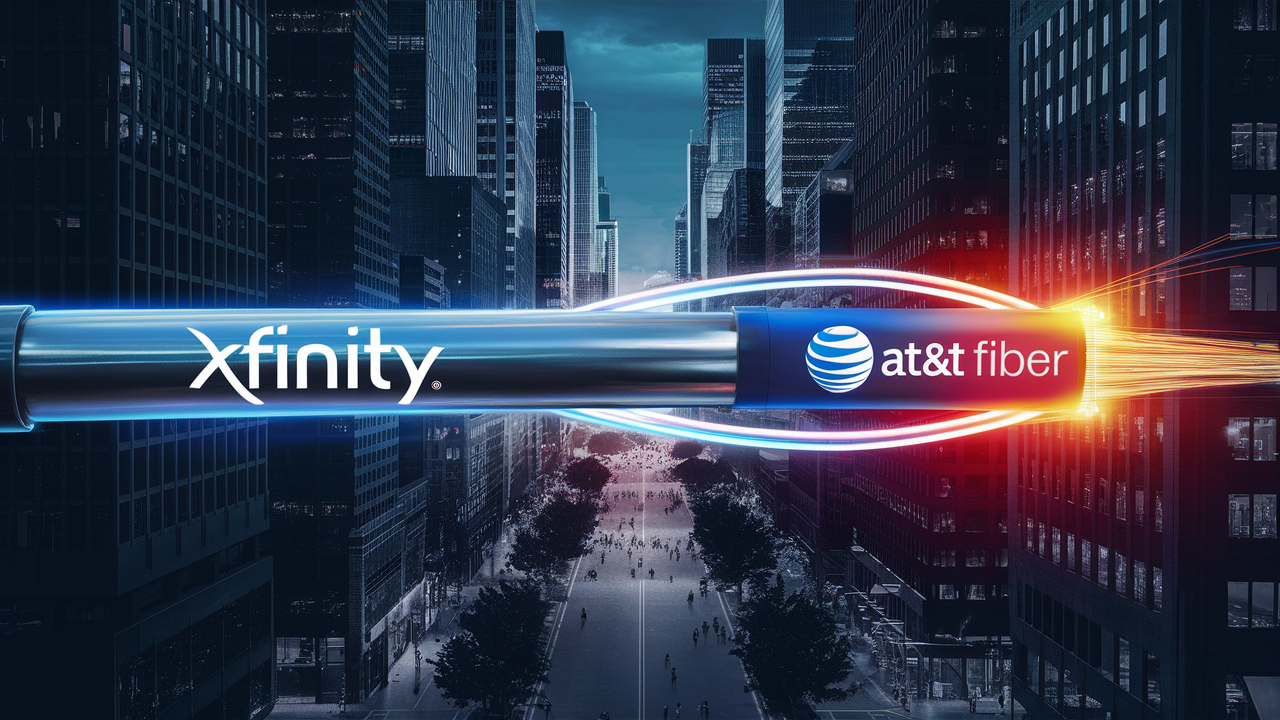How To Restart Xfinity Modem?

Experiencing slow internet or connectivity issues with your Xfinity service? Often, the simplest solution is a quick modem restart. This guide will walk you through exactly how to restart your Xfinity modem, ensuring you get back online efficiently and troubleshoot common problems effectively. We cover multiple methods to suit your needs.
What is a Modem Restart and Why Do It?
A modem restart, often referred to as a power cycle, is the process of temporarily disconnecting your modem from its power source and then reconnecting it. This action forces the modem to re-establish its connection with your Internet Service Provider (ISP), Xfinity in this case, and reinitialize its internal processes. Think of it as giving your modem a fresh start. This simple procedure can resolve a surprisingly wide range of internet connectivity problems, from slow speeds and intermittent drops to complete connection failures. In 2025, with the increasing demand for stable, high-speed internet for remote work, online learning, and immersive entertainment, ensuring your modem is functioning optimally is more critical than ever. A reboot can clear temporary glitches, refresh IP addresses, and often restores your internet service without the need for professional intervention. It’s the first and most fundamental troubleshooting step for any home network issue.
The Benefits of a Regular Modem Restart
While a restart is primarily a troubleshooting tool, performing it periodically can also proactively maintain your internet performance. Here are some key benefits:
- Resolves temporary glitches: Like any electronic device, modems can encounter minor software or hardware hiccups that a restart can clear.
- Resets IP addresses: Your modem obtains an IP address from Xfinity. A restart can help secure a new, potentially better, IP address if the current one is causing issues.
- Improves connection stability: A refreshed connection can lead to a more consistent and reliable internet experience.
- Boosts speeds: Sometimes, a modem can become bogged down over time, and a restart can help it operate at its optimal speed.
- Prepares for new equipment: If you're upgrading your router or other network devices, restarting your modem first is often recommended.
When is a Modem Restart Necessary?
You should consider restarting your Xfinity modem when you notice any of the following:
- Slow internet speeds that are not consistent with your subscribed plan.
- Intermittent internet connection drops, where your Wi-Fi disconnects and reconnects frequently.
- No internet connection at all, despite all lights on the modem appearing normal.
- Issues with specific devices connecting to the network.
- After significant network changes, such as adding new devices or firmware updates.
- As a first step when troubleshooting any internet-related problem.
Preparing for Your Xfinity Modem Restart
Before you begin the process of restarting your Xfinity modem, taking a few preparatory steps can ensure a smoother experience and help you identify if the restart was successful. These steps are crucial for accurate troubleshooting and to avoid unnecessary frustration.
Gather Necessary Information
While restarting the modem itself is straightforward, having certain information handy can be beneficial, especially if the restart doesn't resolve your issue. By 2025, most users will have their account details readily accessible digitally, but it's good practice to know where they are.
- Account Number: This is essential if you need to contact Xfinity support.
- Modem Model Number: Knowing your modem's model can help if you need to look up specific troubleshooting guides or communicate with support. You can usually find this on a sticker on the modem itself.
- Your Xfinity Username and Password: These are needed if you plan to use the Xfinity app or web portal for the restart.
Understand Your Modem and Router Setup
It's important to distinguish between your modem and your router. The modem is the device that connects your home to Xfinity's network, translating the signal from the cable line into a usable internet connection. The router, which may be a separate device or integrated into a modem/router combo unit (often called a gateway), broadcasts your Wi-Fi signal and manages your home network. A restart typically applies to the modem, but if you have a combo unit, restarting it will also restart the router functionality. Understanding this distinction is key, as sometimes the issue might be with the router rather than the modem.
Locate Your Modem
Find your Xfinity modem. It's usually connected to the coaxial cable outlet (the screw-on cable port) on your wall and to a power outlet. Ensure you have easy access to its power cord and any buttons it might have.
Note Current Status Lights
Before you unplug anything, take a moment to observe the status lights on your modem. Note which lights are on, off, or blinking, and their colors. This information can be invaluable for diagnosing problems. For example, a solid "Online" or "Internet" light typically indicates a good connection, while a blinking or absent light suggests a problem. These lights are your modem's way of communicating its operational status.
Consider the Impact on Your Network
When you restart your modem, your entire home network will temporarily lose internet connectivity. This means any devices connected to your Wi-Fi or directly via Ethernet cable will be disconnected. If you are in the middle of an important video call, downloading a large file, or playing an online game, plan your modem restart for a time when these activities are not critical. This is a minor inconvenience for a potentially significant fix.
The Classic Manual Restart: Step-by-Step Guide
The most common and often most effective way to restart your Xfinity modem is through a manual power cycle. This method is universally applicable and requires no special apps or online accounts. It's the tried-and-true approach that has been solving connectivity issues for decades.
Step 1: Disconnect the Power
Locate the power cord connected to the back of your Xfinity modem. Gently unplug this cord from the modem itself or from the wall outlet. You should see the lights on the modem immediately turn off. This is the critical first step in initiating the restart process.
Step 2: Wait for the Modem to Fully Power Down
This is a crucial step that many people overlook. It's not enough to just unplug the power; you need to allow the modem's internal components to discharge completely. A wait of at least 30 to 60 seconds is recommended. Some experts suggest waiting up to two minutes for older or more complex devices. This waiting period ensures that all temporary memory and processes within the modem are cleared, making the subsequent restart more effective. Think of it as giving the device a full reset.
Step 3: Reconnect the Power
After the waiting period has elapsed, plug the power cord back into the modem or the wall outlet. Ensure it's securely connected. The modem will now begin its startup sequence.
Step 4: Observe the Modem's Boot-Up Sequence
Your modem will go through a series of stages as it powers up. This typically involves several lights blinking and changing color. The exact sequence and the meaning of the lights vary by modem model, but generally, you'll see lights for power, downstream, upstream, and online connectivity. This process can take anywhere from 2 to 10 minutes, depending on your modem and the network conditions. Be patient and let it complete.
- Power Light: Should be solid.
- Downstream/Receive Light: Should become solid, indicating it's receiving data from Xfinity.
- Upstream/Send Light: Should become solid, indicating it's sending data back to Xfinity.
- Online/Internet Light: This is the most important. It should eventually become solid, indicating a successful connection to the Xfinity network.
Step 5: Check Your Internet Connection
Once the "Online" or "Internet" light on your modem is solid, your modem has re-established its connection. Now, try connecting to the internet with a device. You can do this by opening a web browser and trying to visit a website. If you can browse the internet, your modem restart was successful. If you still have issues, proceed to the troubleshooting section.
Example: Manual Restart for a Comcast Gateway (Combo Unit)
If you have an Xfinity Gateway (a modem and router combined), the manual restart process is identical. You unplug the power, wait 30-60 seconds, plug it back in, and wait for the lights to stabilize. The lights might indicate Wi-Fi status as well, but the primary focus for internet connectivity is the "Online" or "Internet" light.
Restarting Your Xfinity Modem via the Xfinity App
For a more convenient and often quicker restart, Xfinity provides the My Account app (formerly Xfinity My Account) which allows you to manage your services, including restarting your modem remotely. This is particularly useful if you're away from home or prefer not to physically interact with the modem.
Step 1: Download and Install the Xfinity App
If you haven't already, download the Xfinity app from your device's app store (available for both iOS and Android). Ensure you have a stable internet connection on your mobile device to do this. As of 2025, the app is a standard tool for Xfinity customers.
Step 2: Log In to Your Account
Open the Xfinity app and log in using your Xfinity username and password. If you've forgotten your credentials, you can usually recover them through the app or the Xfinity website.
Step 3: Navigate to the "Connect" or "Internet" Section
Once logged in, look for a section related to your internet service. This is typically labeled "Connect," "Internet," or "My Services." The exact layout may vary slightly with app updates, but the functionality remains consistent.
Step 4: Select Your Modem/Gateway
Within the internet section, you should see a list of your Xfinity devices. Select your modem or gateway. If you have multiple devices, ensure you choose the correct one associated with your internet service.
Step 5: Initiate the Modem Restart
You should find an option to "Restart Modem," "Reboot Device," or something similar. Tap this option. The app will then send a command to your modem to initiate a restart. You'll typically see a confirmation message indicating that the restart process has begun.
Step 6: Monitor the Restart Process
The app may provide real-time updates on the modem's status as it restarts. This is generally faster than a manual restart, often taking 5-7 minutes. You will lose internet connectivity on all your devices during this time. Once the app indicates the modem has successfully reconnected, test your internet connection.
Advantages of Using the Xfinity App
- Convenience: Restart your modem from anywhere with an internet connection.
- Speed: Often faster than waiting for a manual reboot.
- Simplicity: User-friendly interface requires minimal technical knowledge.
- Troubleshooting: The app can sometimes provide diagnostic information.
Restarting Your Xfinity Modem via the Xfinity Web Portal
Similar to the mobile app, Xfinity also offers a web-based portal where you can manage your account and services, including remotely restarting your modem. This is a great option if you're using a computer or prefer a web interface.
Step 1: Access the Xfinity Website
Open a web browser on your computer or any device with internet access and navigate to the official Xfinity website (www.xfinity.com).
Step 2: Log In to Your Account
Click on the "Sign In" or "My Account" button, usually found in the top right corner of the page. Enter your Xfinity username and password to log in. If you don't have an account or have forgotten your credentials, follow the prompts to create one or recover your password.
Step 3: Navigate to Your Services or Equipment
Once logged in, look for a section that details your services or internet equipment. This might be under "My Account," "Internet," or "My Services." The exact wording and location can change with website updates, but the goal is to find where your modem is listed.
Step 4: Locate Your Modem and the Restart Option
Find your Xfinity modem or gateway in the list of your equipment. There should be an option associated with it to "Restart Modem," "Reboot Device," or a similar command. Click on this option.
Step 5: Confirm the Restart
A confirmation prompt will likely appear, asking you to confirm that you want to restart your modem. Confirm your choice. The website will then send the command to your modem.
Step 6: Wait for the Modem to Come Back Online
The web portal may display the status of your modem as it restarts. This process typically takes about 5-7 minutes. During this time, your internet connection will be interrupted. Once the portal indicates that the modem is back online, test your internet connection on your devices.
Comparison: App vs. Web Portal Restart
Both the Xfinity app and the web portal offer similar functionality for restarting your modem. The choice between them often comes down to personal preference and the device you have available. The app is more portable and convenient for on-the-go management, while the web portal is ideal for desktop users. Both are effective and designed to simplify network management for Xfinity customers.
| Feature | Xfinity App | Xfinity Web Portal |
|---|---|---|
| Accessibility | Mobile devices (smartphones, tablets) | Any device with a web browser (computers, tablets, phones) |
| Ease of Use | Intuitive, designed for mobile interaction | Standard web interface, familiar to most users |
| Restart Speed | Typically 5-7 minutes | Typically 5-7 minutes |
| Other Features | Network monitoring, Wi-Fi settings, plan details, troubleshooting tools | Account management, billing, service upgrades, equipment details |
Troubleshooting After Your Xfinity Modem Restart
While a modem restart is often the magic bullet for internet problems, it doesn't always solve everything. If you've followed the steps and your internet is still not working, or if the problem persists, it's time to dig a little deeper. By 2025, many common issues are well-documented, and a systematic approach can help you pinpoint the cause.
Check Modem Lights Again
After the restart, revisit the status lights on your modem. What do they indicate now?
- No Power Light: Ensure the modem is plugged in and the outlet is working. Try a different outlet.
- Flashing or Absent Online/Internet Light: This is the most common sign of a connection issue. It means the modem is struggling to establish a stable link with Xfinity's network.
- Solid Power, but No Other Lights: This could indicate a faulty modem or a problem with the coaxial cable connection.
- Specific Error Lights: Consult your modem's manual or Xfinity's support resources for the meaning of any unusual blinking patterns or specific error lights.
Verify Physical Connections
Loose or damaged cables are a frequent culprit.
- Coaxial Cable: Ensure the coaxial cable is screwed tightly into both the wall outlet and the back of the modem. Check for any visible damage, kinks, or sharp bends in the cable.
- Ethernet Cable (if applicable): If you're connecting a router or computer directly via Ethernet, ensure the cable is securely plugged into both the modem/gateway and the device. Try a different Ethernet cable if possible.
- Power Cable: Make sure the power cable is firmly seated in both the modem and the power outlet.
Test with a Wired Connection
If you primarily use Wi-Fi, try connecting a computer directly to your modem or gateway using an Ethernet cable. If the wired connection works, the issue is likely with your Wi-Fi router or its settings, not the modem itself. This helps isolate the problem. If you have a combo unit (gateway), this test is even more critical.
Check for Service Outages
It's possible the problem isn't with your equipment at all but with Xfinity's service in your area.
- Xfinity Status Center: Use the Xfinity app or log in to the Xfinity website to check the "Status Center." This tool provides real-time information on any known outages affecting your service area.
- Outage Maps: Some ISPs provide online outage maps that can show reported issues in your neighborhood.
Test Another Device
Try connecting a different device to your network. If only one device is having trouble, the issue might be with that specific device's network settings or hardware, not the modem or the internet service.
Consider Your Router (if separate)
If you have a separate router connected to your Xfinity modem, the router itself might be the source of the problem. You can try restarting your router separately (unplug its power, wait 30 seconds, plug it back in) or performing a factory reset on the router if necessary. Consult your router's manual for specific instructions.
| Symptom | Possible Cause | Action |
|---|---|---|
| No Internet After Restart | Modem not connecting to Xfinity network | Check modem lights, verify coaxial connection, check for service outages. |
| Slow Speeds Persist | Network congestion, router issue, outdated equipment | Test wired connection, restart router, check speed test results against plan. |
| Intermittent Disconnects | Loose cables, Wi-Fi interference, faulty modem/router | Secure all connections, reposition router, consider equipment upgrade. |
| Only Some Devices Affected | Device-specific issue, Wi-Fi range problem | Restart affected device, check Wi-Fi signal strength, test device on another network. |
When to Call Xfinity Support
If you've gone through the troubleshooting steps and your internet connection is still not restored, or if you're experiencing recurring issues, it's time to escalate the problem to Xfinity's customer support. By 2025, support channels are more integrated than ever, offering multiple ways to get help. Knowing when to call is as important as knowing how to troubleshoot.
Signs You Should Contact Xfinity
- Persistent "Online" Light Issues: If the "Online" or "Internet" light on your modem remains off, blinking, or shows an error pattern after multiple restarts and checks, there's likely a problem with the signal coming into your home or with Xfinity's network infrastructure.
- No Internet for Extended Periods: If you've been without internet for more than a few hours and a service outage hasn't been reported in your area, it's time to get professional help.
- Frequent and Unexplained Disconnects: If your internet connection drops multiple times a day, even after troubleshooting, it might indicate a more significant issue that Xfinity needs to address.
- Slow Speeds Consistently Below Your Plan: While a restart can help, if your speeds are consistently much lower than what you pay for, Xfinity support can diagnose potential line issues or equipment limitations.
- New Equipment Not Working: If you've installed a new Xfinity modem or gateway and it's not activating or connecting, support can guide you through the activation process or identify any provisioning issues.
- Physical Damage to Equipment: If your modem or any related cables appear physically damaged, contact Xfinity for replacements.
- Uncertainty About Troubleshooting: If you're uncomfortable performing certain troubleshooting steps or aren't sure how to interpret the results, support agents are trained to guide you.
How to Contact Xfinity Support
Xfinity offers several convenient ways to get in touch:
- Phone: You can find the customer service number on your bill or by searching online. This is often the quickest way to speak with a representative for immediate assistance.
- Xfinity App/Website: As mentioned earlier, the Xfinity app and website often have chat support options or direct links to schedule a call or technician visit.
- Social Media: Xfinity often has active customer support channels on platforms like Twitter, where you can reach out for assistance.
- In-Person: Xfinity retail stores or service centers can provide in-person support for certain issues.
What to Tell Support
When you contact Xfinity support, be prepared to provide them with information to expedite the process:
- Your account number.
- The make and model of your modem/gateway.
- A clear description of the problem you're experiencing.
- The troubleshooting steps you've already taken (e.g., modem restart, checked cables, tested wired connection).
- The status of your modem's lights.
- Any error messages you've encountered.
Providing this information upfront will help the support agent diagnose the issue more efficiently and determine the best course of action, whether it's a remote fix, a technician visit, or equipment replacement.
Advanced Tips for Modem Management
Beyond basic restarts, there are several advanced strategies and considerations for managing your Xfinity modem and ensuring optimal internet performance. As home networks become more complex in 2025, understanding these can save you time and frustration.
Understanding Modem Specifications
Not all modems are created equal. Xfinity has specific requirements for compatible modems. If you own your modem, ensure it meets the latest standards (e.g., DOCSIS 3.1 for gigabit speeds) and is on Xfinity's approved device list. Using an outdated or incompatible modem can lead to performance issues and may eventually result in service disruption.
- DOCSIS Standards: DOCSIS 3.0 is standard for many plans, but DOCSIS 3.1 is essential for gigabit speeds and future-proofing.
- Channel Bonding: Higher numbers of bonded downstream and upstream channels generally mean better performance and stability.
- Manufacturer Reputation: Stick with reputable brands like Arris, Netgear, or Motorola for owned modems.
Firmware Updates
Modem firmware is software that controls the device's operations. Xfinity typically pushes firmware updates remotely to their approved modems. If you own your modem, it's crucial to ensure it's receiving these updates. Sometimes, a manual check or a restart can prompt an update. Outdated firmware can be a security risk and a source of performance problems.
Monitoring Your Connection
For tech-savvy users, monitoring your modem's performance can provide early warnings of issues. Many modems have a web interface (often accessible by typing the modem's IP address, like 192.168.100.1, into a browser) that shows signal levels, error logs, and connection status. While Xfinity typically manages this remotely, understanding these metrics can be helpful for advanced troubleshooting.
- Signal Strength: Look for downstream power levels between -7 dBmV and +7 dBmV, and upstream power levels between +35 dBmV and +50 dBmV.
- SNR (Signal-to-Noise Ratio): A higher SNR is better; aim for 33 dB or higher for downstream and 30 dB or higher for upstream.
- Corrected/Uncorrected Errors: Ideally, these should be zero or very low. High numbers indicate signal quality issues.
The Difference Between Modems and Gateways
As previously mentioned, a gateway is a combined modem and router. While convenient, it can sometimes be less flexible than a separate modem and router. If you experience Wi-Fi issues with a gateway, you might consider purchasing your own high-performance router and putting the Xfinity gateway into "bridge mode." This disables the gateway's routing functions, allowing your own router to manage your home network, which can often provide better Wi-Fi coverage and features.
When to Consider Upgrading Your Modem
Technology evolves rapidly. By 2025, many homes are using gigabit internet speeds, which require DOCSIS 3.1 modems. If your current modem is several years old, it might be a bottleneck for your internet speed. Xfinity's rental modems are usually kept up-to-date, but if you own your equipment, check if it's still capable of supporting your subscribed speeds. An upgrade can unlock the full potential of your internet plan.
Security Best Practices
Ensure your Xfinity modem (or gateway) has a strong, unique password for its administrative interface. Also, ensure your Wi-Fi network is secured with WPA2 or WPA3 encryption. Regularly changing your Wi-Fi password can also enhance security.
Conclusion
Mastering how to restart your Xfinity modem is an essential skill for any internet user. Whether you're facing slow speeds, intermittent drops, or a complete outage, a simple power cycle is often the quickest and most effective first step. We've explored the manual unplug method, the convenience of the Xfinity app, and the accessibility of the web portal, providing you with multiple avenues to get your connection back online. Remember the crucial waiting period of 30-60 seconds to allow the modem to fully reset. Beyond the restart, we've armed you with troubleshooting tips, from checking modem lights and physical connections to verifying service outages and testing wired connections. If these steps don't resolve your issues, knowing when to contact Xfinity support and what information to provide can expedite their assistance. By understanding your equipment, performing regular maintenance, and knowing the troubleshooting hierarchy, you can ensure a more stable and reliable internet experience. Don't let connectivity issues disrupt your day; take control with these straightforward Xfinity modem restart and management techniques.





